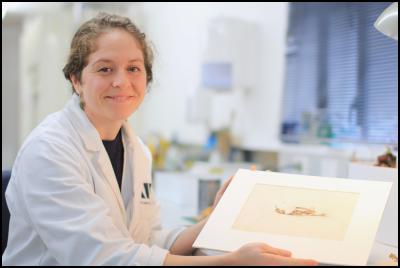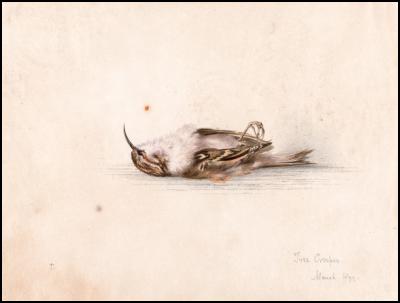British scientist’s painting discovered in Antarctica

Josefin Bergmark-Jimenez with the water colour
Revered British scientist’s painting discovered in Antarctica’s first building
The New Zealand Antarctic Heritage Trust has discovered an almost perfectly preserved 118 year old watercolour painting among penguin-excrement, dust and mould covered papers found in an historic hut at Cape Adare, Antarctica.
The water colour was painted by Dr Edward Wilson who died with Captain Robert Falcon Scott and three others on their return from the South Pole in 1912.
Born in 1872, Dr Wilson is much celebrated in his hometown Cheltenham in England.Cheltenham’s art gallery and museum is named The Wilson and has a permanent collection of his work. His bronze statue (designed by Scott’s widow Lady Kathleen Scott) stands outside the town’s municipal buildings. A primary school in Paddington, London also bears his name.
Antarctic Heritage Trust Paper Conservator Josefin Bergmark-Jimenez found the painting. She was cleaning a paper portfolio collected from a bunk in one of two historic huts the Trust is to restore at Cape Adare.
“I opened it and there was this gorgeous painting… I got such a fright that I jumped and shut the portfolio again. I then took the painting out and couldn’t stop looking at it - the colours, the vibrancy, it is such a beautiful piece of work. I couldn’t believe it was there.”

The painting is labelled ‘1899 Tree Creeper’ and has the initial ‘T’ on it. It depicts a Tree Creeper bird specimen. The discovery was made in September 2016, but has been kept confidential until now to enable the team to focus on restoring all of the 1,500 artefacts from Cape Adare.
The Trust’s Programme Manager – Artefact Conservation, Lizzie Meek says it wasn’t immediately clear who the artist was given that two expeditions had based themselves at Cape Adare.
“The Cape Adare huts were built by Norwegian Carsten Borchgrevink’s expedition in 1899 and later used by Captain Scott’s party in 1911. We knew the artist was likely to be among the men on those expeditions,” says Lizzie.
As the Trust was working to identify the artist, Josefin attended a lecture at Canterbury University on Dr Wilson.
“The presenter showed some of Dr Wilson’s artwork… as soon as I saw his distinctive handwriting, I knew he had painted the Tree Creeper. This made sense as there was also a 1911 newspaper article from the Lyttelton Times in the papers and Scott’s party went to Antarctica via New Zealand.”
Lizzie Meek says Dr Wilson was a remarkable man.
“He was not only a talented painter, but a scientist and a medical doctor who was an integral member of both of Scott’s expeditions to the Ice.”
Josefin is not surprised the painting survived in such excellent condition.
“Water colour paintings are particularly susceptible to light so the fact this work has spent more than a hundred years tightly packed between other sheets of paper in completely dark and cold conditions is actually an ideal way to store it.”
Lizzie Meek says how the painting came to be in the hut is still something of a mystery.
“It’s likely that Wilson painted it while he was recovering from tuberculosis in Europe.
Clearly, he could have taken the painting to Antarctica on either of Scott’s expeditions but we think it’s more likely the artwork travelled with him in 1911, and somehow made its way from Cape Evans to Cape Adare.”
The permit the Trust was granted to collect the artefacts stipulates that all of the items must be returned to the site following conservation, in accordance with the site’s status as an Antarctic Specially Protected Area (ASPA). This will happen once the huts themselves have been restored.
The Trust’s General Manager of Communications and Operations Francesca Eathorne says finding the painting is a poignant reminder of the inspiring legacy the early polar explorers left behind.
“More than a century later we are still sharing
stories about those expeditions. We’ve been able to create
a high quality facsimile of the painting so we are now
looking forward to sharing it with the rest of the world. We
are in no doubt this will attract global interest –
particularly from our friends in the
UK.”


 Brain Injury NZ: Creating Solutions - ID Card For People With Brain Injury Launched
Brain Injury NZ: Creating Solutions - ID Card For People With Brain Injury Launched University of Auckland: AI Leads To Breakthrough In Knee Surgery
University of Auckland: AI Leads To Breakthrough In Knee Surgery The Label: Independent Music NZ Announces Taite Music Prize IMNZ Classic Record 2025
The Label: Independent Music NZ Announces Taite Music Prize IMNZ Classic Record 2025 Protect NZ Psychology: Psychologists Warn Of Patient Risk From Undertrained Workforce
Protect NZ Psychology: Psychologists Warn Of Patient Risk From Undertrained Workforce PHARMAC: Pharmac Proposing To Fund Two Brands Of Oestradiol Patches
PHARMAC: Pharmac Proposing To Fund Two Brands Of Oestradiol Patches ASB Polyfest: 50th Anniversary Of ASB Polyfest Starts Next Week
ASB Polyfest: 50th Anniversary Of ASB Polyfest Starts Next Week